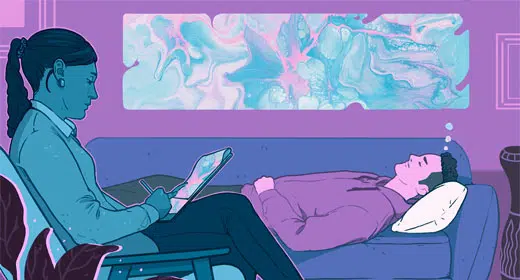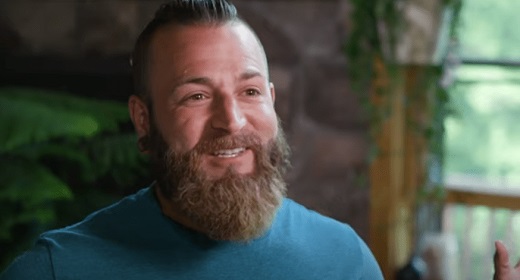by Jonathan Robinson: For the most part, people engage in psychotherapy the same way they did a hundred years ago.
 It didn’t work well a hundred years ago, and it’s not working much better today. Studies show that about one in three people get significant improvement in long term talk therapy—all while paying hundreds or thousands of dollars for treatment. There must be a better way.
It didn’t work well a hundred years ago, and it’s not working much better today. Studies show that about one in three people get significant improvement in long term talk therapy—all while paying hundreds or thousands of dollars for treatment. There must be a better way.
Fortunately, there is. I call it “Microdose Therapy.” What is that? It’s the practice of taking small amounts of certain drugs to facilitate therapeutic breakthroughs. Typically, the most useful drugs are small amounts of LSD, psilocybin (Magic Mushrooms), Ketamine, or MDMA (better known as XTC). Each of these chemicals can create powerful experiences in high dosages. Yet, what is little known is that they are excellent at helping people create powerful changes in their lives at very small dosages.
Most people familiar with taking drugs for personal breakthroughs have used such “medicines” in relatively high dosages. Whether it be an Ayahuasca journey or an LSD “trip,” you can now find many people who guide such journeys. Such guided journeys can indeed be valuable experiences. Yet, I find that people often have a hard time integrating these intense experiences into their daily life. Not so with Microdose Therapy. Because the dosages are small, the insights and experiences gained are easier to integrate into one’s day-to-day life. In fact, many studies now show that chemicals ranging from LSD to MDMA and Ketamine have strong positive effects on people when taken in small doses.
For over thirty years I was a psychotherapist. I was good at my job, but a bit frustrated at how slow the therapeutic process usually was. Then one day a long time client, I’ll call her Linda, had a life changing breakthrough in our session. When seeing Linda the following week, I asked Linda if her breakthrough session had truly changed her life. She assured me it had been a dramatic and ongoing change. Then, she sheepishly revealed to me she had taken a small dose of Magic Mushrooms right before our breakthrough session. In other words, as she put it, “I was a little bit high when I saw you.” Somehow, this small or micro dose of what Linda called “medicine” had significantly accelerated her therapy.
From this humble beginning, I began talking to other clients that I knew who had experimented with drugs, and I told them that some people found it valuable to do therapy on very small amounts of drugs such as XTC, LSD, and psilocybin. Before I knew it, I had many clients coming to me on micro doses of these drugs, and I noticed their improvement skyrocketed. People who had suffered from depression, anxiety, or even trauma reactions were getting better in one-tenth the time it might normally take. It felt like my clients and I were discovering a therapeutic breakthrough.
Now to do micro dosing therapy right, it’s important to realize there are some potential downsides to these drugs. For one, they’re illegal. I don’t tell my clients to take the drugs. I simply offer them information and other people’s experiences. In certain cases these drugs also have abuse potential. Yet, when my clients take these drugs and come to a session, they are normally taking only 1/2 to 1/10th a normal dose. This allows them to be more emotionally “available” and ripe for a breakthrough—without the risks that can come from taking a hefty dose of drugs.
When I started noticing the fast and dramatic changes my clients went through with micro dosing, I decided to try this process on myself. Typically, I would take a small dose—maybe half to three quarters of a gram of Magic Mushrooms, then do some kind of therapeutic process on myself. It didn’t really matter what method I utilized, they all seemed to work a lot—and I mean a lot—better. My wife was soon saying to me, “You seem to be a different person. You’re no longer triggered by me like you used to be. What happened?” Indeed, my clients reported their mates, kids, and co-workers also noticed vast changes in them in a short period of time. It was like magic. In a way, “magic” certainly had something to do with it.
Before long, word got around about what I was doing, and various healers and therapists were asking me about this “new” mode of therapy. So, I came up with the six guidelines for doing successful Microdose Therapy. Here they are:
- Do not try to convince clients to do this therapy—especially if they are not already familiar with these drugs. Instead, if you know clients that have used such things in the past, merely inform them of how some of your clients have taken micro doses before sessions, and had great experiences as a result.
- If your clients request more information, provide it to them. In specific, mention that therapy on high doses of drugs is not easy to do and will not be allowed. Therefore, if they do decide to partake, it should be in amounts that are so small that an outside observer would not necessarily know they’ve taken anything.
- For legal reasons, explain that you are not suggesting what they do, but if they do decide to come to therapy while on low doses of drugs, they are fully responsible for their own safety.
- If, as a healer, you suspect a client has taken some drug, you need not do anything differently than you normally would. However, if the amount that they have taken seems to be interfering with your therapeutic intervention, tell them so.
- Know that certain therapeutic modalities that may have faced resistance when your client was not on drugs may become quite useful and helpful in their new “condition.” In specific, the ability to face difficult feelings and memories may be greatly enhanced, as well as insights about long standing psychological patterns.
- When a client experiences a significant breakthrough—whether on drugs or not—make sure they are emotionally and physically stable before they leave your office. In addition, if possible, briefly check in with them the following day.
Of course, there are many more things that are useful to know when helping people with Microdose Therapy. If you’d like to learn more, feel free to contact me at my email address. Yet, what you have here is a beginning framework for first exploring on yourself, and then perhaps, on an appropriate client. By doing Microdose Therapy on yourself first, you’ll be better prepared to know how to do it with clients.
In order to keep up with the rapid changes in the world, we need better ways to make changes within ourselves. Microdose Therapy is one modality that offers great promise. Not only can it be done on yourself, but when used in the hands of a skilled healer, it can greatly reduce the time it takes to make therapeutic breakthroughs.
Jonathan Robinson is a former psychotherapist, author of 12 books, and has been a frequent guest on Oprah and CNN. His website is FindingHappiness.com, and email is iamjonr@aol.com









































